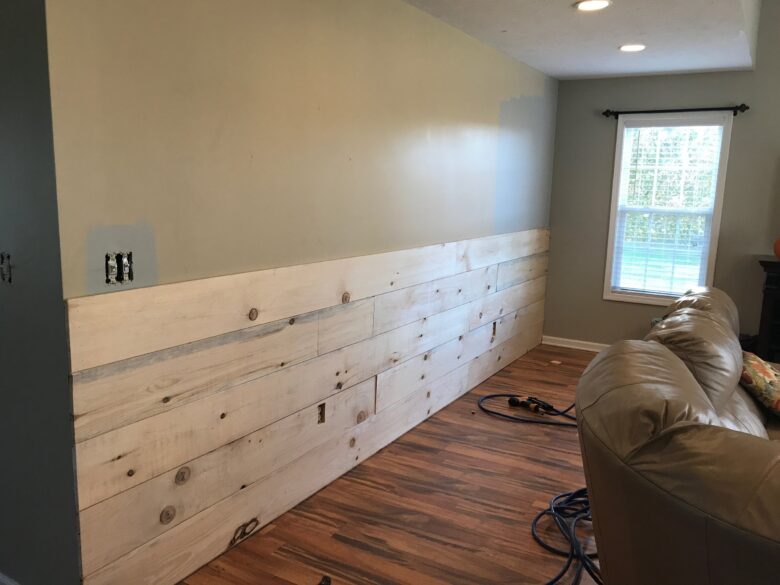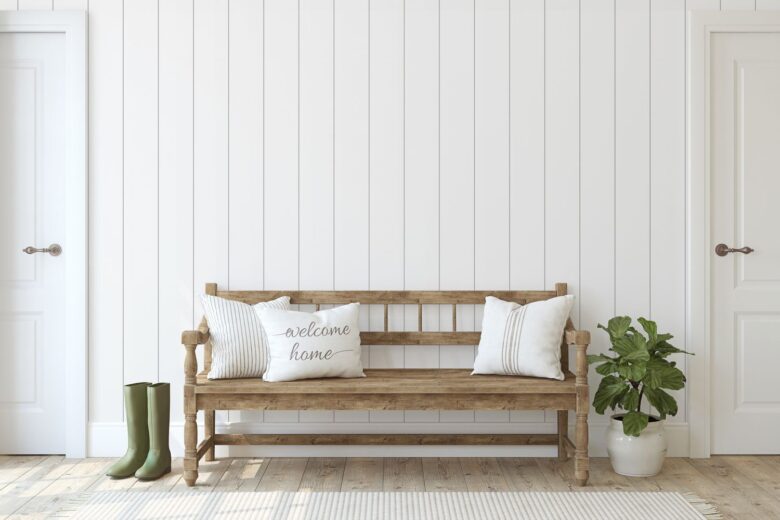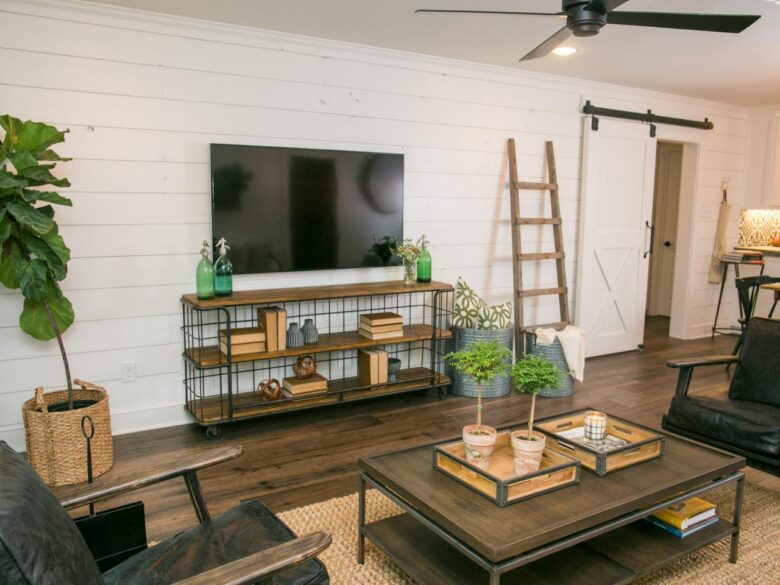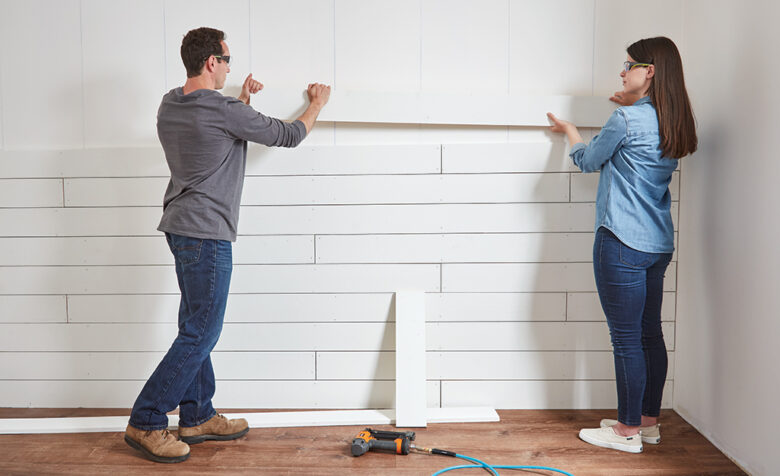Step into a home adorned with shiplap paneling, and you’re greeted with the warmth of rustic allure. This wood paneling, often associated with coastal and farmhouse styles, has transcended design trends to secure its place in the annals of timeless home décor. Let’s journey through the intricate world of shiplap, unraveling its characteristics and exploring its endless applications.
Characteristics
Distinctive and captivating, shiplap paneling is identified by the groove or “rabbet” that allows each board to overlap the next seamlessly. This rabbet not only offers a shadow line between boards but also ensures a tighter fit, preventing unwanted drafts and adding insulation.
Beyond its practical applications, shiplap has a tactile appeal. Its horizontal arrangement draws the eye, extending spaces and creating a rhythmic design continuity. The wide planks exude warmth, making any room feel cozy and inviting.
Installation Techniques and Considerations

When considering installation, preparation is paramount. Begin by accurately measuring the space, ensuring you purchase the right quantity of wood. Then, decide whether you’ll be installing it directly onto the studs or over an existing surface.
While placing a shiplap vertically can elongate a space, horizontal installation remains the most popular choice due to its traditional charm. Whichever direction you opt for, ensure that your boards are level, and utilize a spacer to maintain consistent gaps. This ensures ventilation and prevents warping.
Choosing the Right Type of Wood
Pine and cedar are two of the most popular woods used in shiplap projects due to their cost-effectiveness and ease of installation. Pine, with its smooth texture and pale hue, offers a minimalist feel, while cedar, known for its rich undertones, adds depth to interiors.
Yet, it’s crucial to match wood types with the specific needs of your space. If you’re aiming for a more luxurious look, hardwoods like oak or walnut are worth the investment. Remember, the wood type determines not just the aesthetics, but also the panel’s durability.
Enhancing Interior Design

Shiplap’s versatility has endeared it to designers. In contemporary spaces, it provides a contrast, grounding sleek modern elements with its rustic charm. While in traditional settings, shiplap reinforces the heritage feel, resonating with classic designs.
Beyond style considerations, shiplap acts as an acoustic barrier. Its structure minimizes sound transmission, making it an ideal choice for rooms where serenity is desired, like bedrooms or home offices. This acoustic advantage positions it as both a design and functional asset.
Modern vs. Traditional Spaces
Modern interiors, characterized by clean lines and stark surfaces, are beautifully complemented by shiplap. The wood brings texture and warmth, breaking the monotony and adding depth. Think of a modern loft with a shiplap-clad feature wall, effortlessly fusing the old and new.
On the flip side, in spaces echoing traditional vibes, shiplap acts as a bridge to bygone eras. It recalls simpler times, evoking memories of ancestral homes, yet never feels outdated. Whether juxtaposed with contemporary elements or accentuating classic designs, it remains evergreen.
Incorporating Different Rooms

The beauty of shiplap lies in its adaptability. In a living room, it can become a feature wall behind a fireplace, while in a bathroom, it can offer a spa-like ambiance when paired with modern fixtures. Imagine the cozy vibe of a shiplap-clad bedroom or the welcoming nature of an entryway enhanced with its presence.
Kitchens, too, embrace shiplap’s elegance. Whether applied as a backsplash, an island’s face, or ceiling panels, shiplap introduces a touch of farmhouse chic. Its versatility ensures that no room is off-limits, allowing homeowners to infuse spaces with its timeless appeal.
Color and Finish Options
While many adore the natural hues of wood, shiplap can be customized to suit various color palettes. Whites and creams offer a breezy, coastal feel, while darker shades can create a sophisticated ambiance. Pastel hues, on the other hand, bring out a vintage charm.
Finishes, too, can dramatically alter the look of your panels. A matte finish exudes an understated elegance, while a glossy finish can add a touch of glamour. By playing with colors and finishes, one can tailor to complement any interior style.
Maintenance and Longevity

With its sturdy nature, shiplap promises longevity. Regular dusting and occasional wiping with a damp cloth are all it usually demands. For painted panels, periodic touch-ups can keep them looking fresh.
Protection from excessive moisture is essential. In humid areas, consider sealing the wood to prevent warping and swelling. By attending to these minor care practices, you can ensure that your shiplap remains a long-lasting testament to your design prowess.
Exterior Applications
Beyond interiors, shiplap’s charm extends to exterior settings. It serves as a captivating façade for homes, lending them a cottage-esque charisma. When sealed appropriately, it can brave the elements, becoming a durable shield against weather vagaries.
Yet, for such applications, it’s vital to choose woods like cedar, known for their weather-resistant properties. Proper spacing, ensuring airflow between the panels, and using quality sealants will ensure your exterior shiplap stands the test of time.
DIY Projects and Ideas

For the DIY enthusiasts, shiplap offers a canvas to showcase creativity. Simple projects like creating headboards, coffee tables, or shelving units can inject personality into spaces. With basic tools and a weekend to spare, these undertakings can be both fulfilling and transformative.
If embarking on larger projects, remember the cardinal rules: plan meticulously, measure twice, and cut once. The satisfaction of crafting with shiplap, paired with its undeniable charm, makes every DIY endeavor a rewarding experience.
Commercial and Hospitality Settings
Beyond domestic realms, commercial and hospitality spaces are waking up to shiplap’s allure. Restaurants, with shiplap-clad walls, exude a homely vibe, making patrons feel instantly welcomed. Boutique hotels employ it to create a blend of rusticity and luxury.
In office spaces, shiplap can demarcate zones, offering a visual break in open-plan designs. It adds texture, warmth, and a hint of nostalgia, ensuring these environments don’t feel sterile but are instead infused with character.
Final Words
Shiplap, with its rustic charm and versatile nature, proves its mettle in diverse settings, from cozy homes to bustling commercial spaces. Its timeless appeal, backed by its practical benefits, positions it as a favored choice among design aficionados. As we’ve journeyed through its various facets, one thing remains clear: shiplap isn’t just a design element; it’s an embodiment of enduring elegance.

